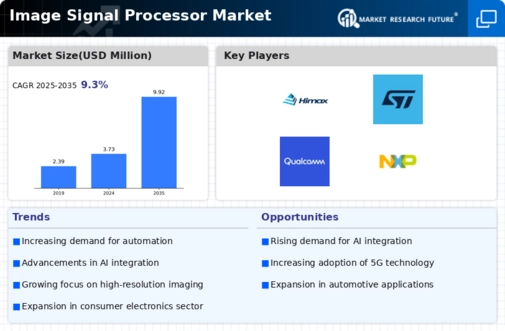-
EXECUTIVE SUMMARY 18
-
MARKET INTRODUCTION 20
-
DEFINITION 20
-
SCOPE OF THE STUDY 20
-
RESEARCH OBJECTIVE 20
-
MARKET STRUCTURE 21
-
RESEARCH METHODOLOGY 22
-
DATA MINING 22
-
SECONDARY RESEARCH 23
-
PRIMARY RESEARCH 23
- PRIMARY INTERVIEWS AND INFORMATION GATHERING PROCESS 23
- BREAKDOWN OF PRIMARY RESPONDENTS 24
-
RESEARCH METHODOLOGY FOR MARKET SIZE ESTIMATION 26
- BOTTOM-UP APPROACH 27
- TOP-DOWN APPROACH 27
-
DATA VALIDATION 28
-
ASSUMPTIONS & LIMITATIONS 28
-
MARKET DYNAMICS 29
-
INTRODUCTION 29
-
DRIVERS 31
- GROWING DEMAND FOR HIGH QUALITY IMAGING IN SMARTPHONE 31
- RISE OF AUTOMOTIVE ADVANCED DRIVER ASSISTANCE SYSTEM 31
- SURGE IN SECURITY AND SURVEILLANCE APPLICATION 32
-
RESTRAINT 33
- COST CONSTRAINTS IN MASS MARKET DEVICES 33
- COMPLEXITY IN INTEGRATION WITH OTHER COMPONENTS 33
-
OPPORTUNITIES 34
- EXPANSION OF INTERNET OF THINGS (IOT) DEVICES 34
- RAPID DEVELOPMENT IN VIRTUAL AND AUGMENTED REALITY (VR/AR) 35
-
CHALLENGES 35
- REGULATORY COMPLIANCE IN AUTOMOTIVE APPLICATION 35
- SUPPLY CHAIN DISRUPTIONS AND SEMICONDUCTOR SHORTAGES 36
-
-
MARKET FACTOR ANALYSIS 37
-
SUPPLY CHAIN ANALYSIS 37
- RAW MATERIAL SUPPLIERS 38
- SEMICONDUCTOR FOUNDRIES 38
- MANUFACTURING AND ASSEMBLY 38
- ISP MANUFACTURERS 38
- DEVICE ASSEMBLY AND INTEGRATION 39
- DISTRIBUTION AND LOGISTICS 39
- END USERS 39
-
PORTER’S FIVE FORCES MODEL 40
- BARGAINING POWER OF SUPPLIERS 41
- BARGAINING POWER OF BUYERS 41
- THREAT OF NEW ENTRANTS 41
- THREAT OF SUBSTITUTES 42
- INTENSITY OF RIVALRY 42
-
IMPACT OF CORONAVIRUS OUTBREAK ON GLOBAL MARKET 43
- IMPACT ON IMAGE SIGNAL PROCESSOR PROVIDERS 43
- IMPACT ON SEMICONDUCTOR INDUSTRY I 43
- IMPACT ON PRICING 44
-
GLOBAL IMAGE SIGNAL PROCESSORS MARKET, BY TYPE 45
-
INTRODUCTION 45
-
2D 47
-
3D 48
-
GLOBAL IMAGE SIGNAL PROCESSORS MARKET, BY COMPONENT 49
-
INTRODUCTION 49
-
HARDWARE 50
-
SOFTWARE 51
-
GLOBAL IMAGE SIGNAL PROCESSORS MARKET, BY SALES CHANNEL 52
-
INTRODUCTION 52
-
OEM 54
-
AFTERMARKET 54
-
GLOBAL IMAGE SIGNAL PROCESSORS MARKET, BY IMAGE PROCESSING 55
-
INTRODUCTION 55
-
ANALOG IMAGE PROCESSING 57
-
DIGITAL IMAGE PROCESSING 58
-
-
GLOBAL IMAGE SIGNAL PROCESSORS MARKET, BY TECHNOLOGY 59
-
INTRODUCTION 59
-
MULTIPLE INSTRUCTIONS MULTIPLE DATA (MIMD) 61
-
SINGLE INSTRUCTIONS MULTIPLE DATA (MIMD) 62
-
GLOBAL IMAGE SIGNAL PROCESSORS MARKET, BY INDUSTRY VERTICALS 63
-
INTRODUCTION 63
-
AEROSPACE AND DEFENSE 65
-
AUTOMOTIVE 65
-
CONSUMER ELECTRONICS 66
-
HEALTHCARE 66
-
MANUFACTURING 67
-
OTHERS 67
-
GLOBAL IMAGE SIGNAL PROCESSORS MARKET, BY REGION 68
-
OVERVIEW 68
-
NORTH AMERICA 70
- U.S. 73
- CANADA 75
- MEXICO 77
-
EUROPE 79
- GERMANY 82
- FRANCE 84
- U.K. 86
- SPAIN 88
- ITALY 90
- ROE 92
-
ASIA-PACIFIC 94
- CHINA 97
- JAPAN 99
- INDIA 101
- SOUTH KOREA 103
- ROAPAC 105
-
MIDDLE EAST AND AFRICA 107
- SAUDI ARABIA 110
- UAE 112
- SOUTH AFRICA 114
- ROMEA 116
-
-
SOUTH AMERICA 118
- BRAZIL 121
- ARGENTINA 123
- CHILE 125
- ROSA 127
-
COMPETITIVE LANDSCAPE 129
-
COMPETITIVE OVERVIEW 129
-
COMPETITIVE BENCHMARKING 130
-
VENDOR SHARE ANALYSIS 131
-
KEY DEVELOPMENTS & GROWTH STRATEGIES 132
- NEW PRODUCT LAUNCH/SERVICE DEPLOYMENT 132
- PARTNERSHIP, AGREEMENT AND COLLABORATION 133
- EXPANSION 133
-
COMPANY PROFILES 134
-
SONY GROUP CORPORATION 134
- COMPANY OVERVIEW 134
- FINANCIAL OVERVIEW 135
- PRODUCTS OFFERED 135
- KEY DEVELOPMENTS 136
- SWOT ANALYSIS 136
- KEY STRATEGY 137
-
SAMSUNG ELECTRONICS CO., LTD. 138
- COMPANY OVERVIEW 138
- FINANCIAL OVERVIEW 139
- PRODUCTS OFFERED 139
- KEY DEVELOPMENTS 140
- SWOT ANALYSIS 140
- KEY STRATEGY 141
-
OMNIVISION TECHNOLOGIES, INC. 142
- COMPANY OVERVIEW 142
- PRODUCTS OFFERED 142
- KEY DEVELOPMENTS 142
- SWOT ANALYSIS 143
- KEY STRATEGY 143
-
-
ON SEMICONDUCTOR CORPORATION 144
- COMPANY OVERVIEW 144
- FINANCIAL OVERVIEW 145
- PRODUCTS OFFERED 145
- KEY DEVELOPMENTS 146
- SWOT ANALYSIS 146
- KEY STRATEGY 146
-
HIMAX TECHNOLOGIES INC. 147
- COMPANY OVERVIEW 147
- FINANCIAL OVERVIEW 148
- PRODUCTS OFFERED 148
- KEY DEVELOPMENTS 149
- SWOT ANALYSIS 149
- KEY STRATEGY 150
-
STMICROELECTRONICS NV 151
- COMPANY OVERVIEW 151
- FINANCIAL OVERVIEW 152
- PRODUCTS OFFERED 152
- KEY DEVELOPMENTS 153
- SWOT ANALYSIS 153
- KEY STRATEGY 154
-
PANASONIC CORPORATION 155
- COMPANY OVERVIEW 155
- FINANCIAL OVERVIEW 156
- PRODUCTS OFFERED 156
- KEY DEVELOPMENTS 157
- SWOT ANALYSIS 157
- KEY STRATEGY 158
-
FUJITSU LIMITED 159
- COMPANY OVERVIEW 159
- FINANCIAL OVERVIEW 160
- PRODUCTS OFFERED 160
- KEY DEVELOPMENTS 161
- SWOT ANALYSIS 161
- KEY STRATEGY 162
-
-
MEDIATEK INC. 163
- COMPANY OVERVIEW 163
- FINANCIAL OVERVIEW 164
- PRODUCTS OFFERED 164
- KEY DEVELOPMENTS 165
- SWOT ANALYSIS 165
- KEY STRATEGY 166
-
QUALCOMM 167
- COMPANY OVERVIEW 167
- FINANCIAL OVERVIEW 168
- PRODUCTS OFFERED 168
- KEY DEVELOPMENTS 169
- SWOT ANALYSIS 169
- KEY STRATEGY 170
-
NXP SEMICONDUCTORS 171
- COMPANY OVERVIEW 171
- FINANCIAL OVERVIEW 172
- PRODUCTS OFFERED 172
- KEY DEVELOPMENTS 173
- SWOT ANALYSIS 173
- KEY STRATEGY 173
-
HISILICON 174
- COMPANY OVERVIEW 174
- FINANCIAL OVERVIEW 175
- PRODUCTS OFFERED 175
- KEY DEVELOPMENTS 176
- SWOT ANALYSIS 176
- KEY STRATEGY 177
-
TOSHIBA 178
- COMPANY OVERVIEW 178
- FINANCIAL OVERVIEW 179
- PRODUCTS OFFERED 179
- KEY DEVELOPMENTS 180
- SWOT ANALYSIS 180
- KEY STRATEGY 181
-
-
LIST OF TABLES
-
MARKET SYNOPSIS 19
-
LIST OF ASSUMPTIONS 28
-
GLOBAL IMAGE SIGNAL PROCESSORS MARKET, BY TYPE, 2024-2032 (USD MILLION) 45
-
GLOBAL IMAGE SIGNAL PROCESSORS MARKET, BY 2D, BY REGION, 2024-2032 (USD MILLION) 47
-
GLOBAL IMAGE SIGNAL PROCESSORS MARKET, BY 3D, BY REGION, 2024-2032 (USD MILLION) 48
-
GLOBAL IMAGE SIGNAL PROCESSORS MARKET, BY COMPONENT, 2024-2032 (USD MILLION) 49
-
GLOBAL IMAGE SIGNAL PROCESSORS MARKET, BY HARDWARE, BY TYPE, 2024-2032 (USD MILLION) 50
-
GLOBAL IMAGE SIGNAL PROCESSORS MARKET, BY HARDWARE, BY REGION, 2024-2032 (USD MILLION) 50
-
GLOBAL IMAGE SIGNAL PROCESSORS MARKET, BY SOFTWARE, BY REGION, 2024-2032 (USD MILLION) 51
-
GLOBAL IMAGE SIGNAL PROCESSORS MARKET, BY SALES CHANNEL, 2024-2032 (USD MILLION) 52
-
GLOBAL IMAGE SIGNAL PROCESSORS MARKET, BY OEM, BY REGION, 2024-2032 (USD MILLION) 54
-
GLOBAL IMAGE SIGNAL PROCESSORS MARKET, BY AFTERMARKET, BY REGION, 2024-2032 (USD MILLION) 54
-
GLOBAL IMAGE SIGNAL PROCESSORS MARKET, BY IMAGE PROCESSING, 2024-2032 (USD MILLION) 55
-
GLOBAL IMAGE SIGNAL PROCESSORS MARKET, FOR ANALOG IMAGE PROCESSING, BY REGION, 2024-2032 (USD MILLION) 57
-
GLOBAL IMAGE SIGNAL PROCESSORS MARKET, FOR DIGITAL IMAGE PROCESSING, BY REGION, 2024-2032 (USD MILLION) 58
-
GLOBAL IMAGE SIGNAL PROCESSORS MARKET, BY TECHNOLOGY, 2024-2032 (USD MILLION) 59
-
GLOBAL IMAGE SIGNAL PROCESSORS MARKET, FOR MULTIPLE INSTRUCTIONS MULTIPLE DATA (MIMD), BY REGION,
-
GLOBAL IMAGE SIGNAL PROCESSORS MARKET, FOR SINGLE INSTRUCTIONS MULTIPLE DATA (MIMD), BY REGION,
-
GLOBAL IMAGE SIGNAL PROCESSORS MARKET, BY INDUSTRY VERTICALS, 2024-2032 (USD MILLION) 63
-
GLOBAL IMAGE SIGNAL PROCESSORS MARKET, BY AEROSPACE AND DEFENSE, BY REGION, 2024-2032 (USD MILLION) 65
-
GLOBAL IMAGE SIGNAL PROCESSORS MARKET, BY AUTOMOTIVE, BY REGION, 2024-2032 (USD MILLION) 65
-
GLOBAL IMAGE SIGNAL PROCESSORS MARKET, BY CONSUMER ELECTRONICS, BY REGION, 2024-2032 (USD MILLION) 66
-
GLOBAL IMAGE SIGNAL PROCESSORS MARKET, BY HEALTHCARE, BY REGION, 2024-2032 (USD MILLION) 66
-
GLOBAL IMAGE SIGNAL PROCESSORS MARKET, BY MANUFACTURING, BY REGION, 2024-2032 (USD MILLION) 67
-
GLOBAL IMAGE SIGNAL PROCESSORS MARKET, BY OTHERS, BY REGION, 2024-2032 (USD MILLION) 67
-
GLOBAL IMAGE SIGNAL PROCESSORS MARKET, BY REGION, 2024-2032 (USD MILLION) 69
-
NORTH AMERICA: IMAGE SIGNAL PROCESSORS MARKET, BY COUNTRY, 2024-2032 (USD MILLION) 70
-
NORTH AMERICA: IMAGE SIGNAL PROCESSORS MARKET, BY COMPONENTS, 2024-2032 (USD MILLION) 71
-
NORTH AMERICA: IMAGE SIGNAL PROCESSORS MARKET, BY IMAGE PROCESSING, 2024-2032 (USD MILLION) 72
-
NORTH AMERICA: IMAGE SIGNAL PROCESSORS MARKET, BY SALES CHANNEL, 2024-2032 (USD MILLION) 72
-
NORTH AMERICA: IMAGE SIGNAL PROCESSORS MARKET, BY TECHNOLOGY, 2024-2032 (USD MILLION) 72
-
NORTH AMERICA: IMAGE SIGNAL PROCESSORS MARKET, BY TYPE, 2024-2032 (USD MILLION) 72
-
NORTH AMERICA: IMAGE SIGNAL PROCESSORS MARKET, BY INDUSTRY VERTICAL, 2024-2032 (USD MILLION) 73
-
U.S.: IMAGE SIGNAL PROCESSORS MARKET, BY COMPONENTS, 2024-2032 (USD MILLION) 73
-
U.S.: IMAGE SIGNAL PROCESSORS MARKET, BY IMAGE PROCESSING, 2024-2032 (USD MILLION) 73
-
U.S.: IMAGE SIGNAL PROCESSORS MARKET, BY SALES CHANNEL, 2024-2032 (USD MILLION) 74
-
U.S.: IMAGE SIGNAL PROCESSORS MARKET, BY TECHNOLOGY, 2024-2032 (USD MILLION) 74
-
U.S.: IMAGE SIGNAL PROCESSORS MARKET, BY TYPE, 2024-2032 (USD MILLION) 74
-
U.S.: IMAGE SIGNAL PROCESSORS MARKET, BY INDUSTRY VERTICAL, 2024-2032 (USD MILLION) 74
-
CANADA: IMAGE SIGNAL PROCESSORS MARKET, BY COMPONENTS, 2024-2032 (USD MILLION) 75
-
CANADA: IMAGE SIGNAL PROCESSORS MARKET, BY IMAGE PROCESSING, 2024-2032 (USD MILLION) 75
-
CANADA: IMAGE SIGNAL PROCESSORS MARKET, BY SALES CHANNEL, 2024-2032 (USD MILLION) 75
-
CANADA: IMAGE SIGNAL PROCESSORS MARKET, BY TECHNOLOGY, 2024-2032 (USD MILLION) 76
-
CANADA: IMAGE SIGNAL PROCESSORS MARKET, BY TYPE, 2024-2032 (USD MILLION) 76
-
CANADA: IMAGE SIGNAL PROCESSORS MARKET, BY INDUSTRY VERTICAL, 2024-2032 (USD MILLION) 76
-
MEXICO: IMAGE SIGNAL PROCESSORS MARKET, BY COMPONENTS, 2024-2032 (USD MILLION) 77
-
MEXICO: IMAGE SIGNAL PROCESSORS MARKET, BY IMAGE PROCESSING, 2024-2032 (USD MILLION) 77
-
MEXICO: IMAGE SIGNAL PROCESSORS MARKET, BY SALES CHANNEL, 2024-2032 (USD MILLION) 77
-
MEXICO: IMAGE SIGNAL PROCESSORS MARKET, BY TECHNOLOGY, 2024-2032 (USD MILLION) 78
-
MEXICO: IMAGE SIGNAL PROCESSORS MARKET, BY TYPE, 2024-2032 (USD MILLION) 78
-
MEXICO: IMAGE SIGNAL PROCESSORS MARKET, BY INDUSTRY VERTICAL, 2024-2032 (USD MILLION) 78
-
EUROPE: IMAGE SIGNAL PROCESSORS MARKET, BY COUNTRY, 2024-2032 (USD MILLION) 79
-
EUROPE: IMAGE SIGNAL PROCESSORS MARKET, BY COMPONENTS, 2024-2032 (USD MILLION) 80
-
EUROPE: IMAGE SIGNAL PROCESSORS MARKET, BY IMAGE PROCESSING, 2024-2032 (USD MILLION) 81
-
EUROPE: IMAGE SIGNAL PROCESSORS MARKET, BY SALES CHANNEL, 2024-2032 (USD MILLION) 81
-
EUROPE: IMAGE SIGNAL PROCESSORS MARKET, BY TECHNOLOGY, 2024-2032 (USD MILLION) 81
-
EUROPE: IMAGE SIGNAL PROCESSORS MARKET, BY TYPE, 2024-2032 (USD MILLION) 81
-
EUROPE: IMAGE SIGNAL PROCESSORS MARKET, BY INDUSTRY VERTICAL, 2024-2032 (USD MILLION) 82
-
GERMANY: IMAGE SIGNAL PROCESSORS MARKET, BY COMPONENTS, 2024-2032 (USD MILLION) 82
-
GERMANY: IMAGE SIGNAL PROCESSORS MARKET, BY IMAGE PROCESSING, 2024-2032 (USD MILLION) 82
-
GERMANY: IMAGE SIGNAL PROCESSORS MARKET, BY SALES CHANNEL, 2024-2032 (USD MILLION) 83
-
GERMANY: IMAGE SIGNAL PROCESSORS MARKET, BY TECHNOLOGY, 2024-2032 (USD MILLION) 83
-
GERMANY: IMAGE SIGNAL PROCESSORS MARKET, BY TYPE, 2024-2032 (USD MILLION) 83
-
GERMANY: IMAGE SIGNAL PROCESSORS MARKET, BY INDUSTRY VERTICAL, 2024-2032 (USD MILLION) 83
-
FRANCE: IMAGE SIGNAL PROCESSORS MARKET, BY COMPONENTS, 2024-2032 (USD MILLION) 84
-
FRANCE: IMAGE SIGNAL PROCESSORS MARKET, BY IMAGE PROCESSING, 2024-2032 (USD MILLION) 84
-
FRANCE: IMAGE SIGNAL PROCESSORS MARKET, BY SALES CHANNEL, 2024-2032 (USD MILLION) 84
-
FRANCE: IMAGE SIGNAL PROCESSORS MARKET, BY TECHNOLOGY, 2024-2032 (USD MILLION) 85
-
FRANCE: IMAGE SIGNAL PROCESSORS MARKET, BY TYPE, 2024-2032 (USD MILLION) 85
-
FRANCE: IMAGE SIGNAL PROCESSORS MARKET, BY INDUSTRY VERTICAL, 2024-2032 (USD MILLION) 85
-
U.K.: IMAGE SIGNAL PROCESSORS MARKET, BY COMPONENTS, 2024-2032 (USD MILLION) 86
-
U.K.: IMAGE SIGNAL PROCESSORS MARKET, BY IMAGE PROCESSING, 2024-2032 (USD MILLION) 86
-
U.K.: IMAGE SIGNAL PROCESSORS MARKET, BY SALES CHANNEL, 2024-2032 (USD MILLION) 86
-
U.K.: IMAGE SIGNAL PROCESSORS MARKET, BY TECHNOLOGY, 2024-2032 (USD MILLION) 87
-
U.K.: IMAGE SIGNAL PROCESSORS MARKET, BY TYPE, 2024-2032 (USD MILLION) 87
-
U.K.: IMAGE SIGNAL PROCESSORS MARKET, BY INDUSTRY VERTICAL, 2024-2032 (USD MILLION) 87
-
SPAIN: IMAGE SIGNAL PROCESSORS MARKET, BY COMPONENTS, 2024-2032 (USD MILLION) 88
-
SPAIN: IMAGE SIGNAL PROCESSORS MARKET, BY IMAGE PROCESSING, 2024-2032 (USD MILLION) 88
-
SPAIN: IMAGE SIGNAL PROCESSORS MARKET, BY SALES CHANNEL, 2024-2032 (USD MILLION) 88
-
SPAIN: IMAGE SIGNAL PROCESSORS MARKET, BY TECHNOLOGY, 2024-2032 (USD MILLION) 89
-
SPAIN: IMAGE SIGNAL PROCESSORS MARKET, BY TYPE, 2024-2032 (USD MILLION) 89
-
SPAIN: IMAGE SIGNAL PROCESSORS MARKET, BY INDUSTRY VERTICAL, 2024-2032 (USD MILLION) 89
-
ITALY: IMAGE SIGNAL PROCESSORS MARKET, BY COMPONENTS, 2024-2032 (USD MILLION) 90
-
ITALY: IMAGE SIGNAL PROCESSORS MARKET, BY IMAGE PROCESSING, 2024-2032 (USD MILLION) 90
-
ITALY: IMAGE SIGNAL PROCESSORS MARKET, BY SALES CHANNEL, 2024-2032 (USD MILLION) 90
-
ITALY: IMAGE SIGNAL PROCESSORS MARKET, BY TECHNOLOGY, 2024-2032 (USD MILLION) 91
-
ITALY: IMAGE SIGNAL PROCESSORS MARKET, BY TYPE, 2024-2032 (USD MILLION) 91
-
ITALY: IMAGE SIGNAL PROCESSORS MARKET, BY INDUSTRY VERTICAL, 2024-2032 (USD MILLION) 91
-
ROE: IMAGE SIGNAL PROCESSORS MARKET, BY COMPONENTS, 2024-2032 (USD MILLION) 92
-
ROE: IMAGE SIGNAL PROCESSORS MARKET, BY IMAGE PROCESSING, 2024-2032 (USD MILLION) 92
-
ROE: IMAGE SIGNAL PROCESSORS MARKET, BY SALES CHANNEL, 2024-2032 (USD MILLION) 92
-
ROE: IMAGE SIGNAL PROCESSORS MARKET, BY TECHNOLOGY, 2024-2032 (USD MILLION) 93
-
ROE: IMAGE SIGNAL PROCESSORS MARKET, BY TYPE, 2024-2032 (USD MILLION) 93
-
ROE: IMAGE SIGNAL PROCESSORS MARKET, BY INDUSTRY VERTICAL, 2024-2032 (USD MILLION) 93
-
ASIA-PACIFIC: IMAGE SIGNAL PROCESSORS MARKET, BY COUNTRY, 2024-2032 (USD MILLION) 94
-
ASIA-PACIFIC: IMAGE SIGNAL PROCESSORS MARKET, BY COMPONENTS, 2024-2032 (USD MILLION) 95
-
ASIA-PACIFIC: IMAGE SIGNAL PROCESSORS MARKET, BY IMAGE PROCESSING, 2024-2032 (USD MILLION) 96
-
ASIA-PACIFIC: IMAGE SIGNAL PROCESSORS MARKET, BY SALES CHANNEL, 2024-2032 (USD MILLION) 96
-
ASIA-PACIFIC: IMAGE SIGNAL PROCESSORS MARKET, BY TECHNOLOGY, 2024-2032 (USD MILLION) 96
-
ASIA-PACIFIC: IMAGE SIGNAL PROCESSORS MARKET, BY TYPE, 2024-2032 (USD MILLION) 96
-
ASIA-PACIFIC: IMAGE SIGNAL PROCESSORS MARKET, BY INDUSTRY VERTICAL, 2024-2032 (USD MILLION) 97
-
CHINA: IMAGE SIGNAL PROCESSORS MARKET, BY COMPONENTS, 2024-2032 (USD MILLION) 97
-
CHINA: IMAGE SIGNAL PROCESSORS MARKET, BY IMAGE PROCESSING, 2024-2032 (USD MILLION) 97
-
CHINA: IMAGE SIGNAL PROCESSORS MARKET, BY SALES CHANNEL, 2024-2032 (USD MILLION) 98
-
CHINA: IMAGE SIGNAL PROCESSORS MARKET, BY TECHNOLOGY, 2024-2032 (USD MILLION) 98
-
CHINA: IMAGE SIGNAL PROCESSORS MARKET, BY TYPE, 2024-2032 (USD MILLION) 98
-
CHINA: IMAGE SIGNAL PROCESSORS MARKET, BY INDUSTRY VERTICAL, 2024-2032 (USD MILLION) 98
-
JAPAN: IMAGE SIGNAL PROCESSORS MARKET, BY COMPONENTS, 2024-2032 (USD MILLION) 99
-
JAPAN: IMAGE SIGNAL PROCESSORS MARKET, BY IMAGE PROCESSING, 2024-2032 (USD MILLION) 99
-
JAPAN: IMAGE SIGNAL PROCESSORS MARKET, BY SALES CHANNEL, 2024-2032 (USD MILLION) 99
-
JAPAN: IMAGE SIGNAL PROCESSORS MARKET, BY TECHNOLOGY, 2024-2032 (USD MILLION) 100
-
JAPAN: IMAGE SIGNAL PROCESSORS MARKET, BY TYPE, 2024-2032 (USD MILLION) 100
-
JAPAN: IMAGE SIGNAL PROCESSORS MARKET, BY INDUSTRY VERTICAL, 2024-2032 (USD MILLION) 100
-
INDIA: IMAGE SIGNAL PROCESSORS MARKET, BY COMPONENTS, 2024-2032 (USD MILLION) 101
-
INDIA: IMAGE SIGNAL PROCESSORS MARKET, BY IMAGE PROCESSING, 2024-2032 (USD MILLION) 101
-
INDIA: IMAGE SIGNAL PROCESSORS MARKET, BY SALES CHANNEL, 2024-2032 (USD MILLION) 101
-
INDIA: IMAGE SIGNAL PROCESSORS MARKET, BY TECHNOLOGY, 2024-2032 (USD MILLION) 102
-
INDIA: IMAGE SIGNAL PROCESSORS MARKET, BY TYPE, 2024-2032 (USD MILLION) 102
-
INDIA: IMAGE SIGNAL PROCESSORS MARKET, BY INDUSTRY VERTICAL, 2024-2032 (USD MILLION) 102
-
SOUTH KOREA: IMAGE SIGNAL PROCESSORS MARKET, BY COMPONENTS, 2024-2032 (USD MILLION) 103
-
SOUTH KOREA: IMAGE SIGNAL PROCESSORS MARKET, BY IMAGE PROCESSING, 2024-2032 (USD MILLION) 103
-
SOUTH KOREA: IMAGE SIGNAL PROCESSORS MARKET, BY SALES CHANNEL, 2024-2032 (USD MILLION) 103
-
SOUTH KOREA: IMAGE SIGNAL PROCESSORS MARKET, BY TECHNOLOGY, 2024-2032 (USD MILLION) 104
-
SOUTH KOREA: IMAGE SIGNAL PROCESSORS MARKET, BY TYPE, 2024-2032 (USD MILLION) 104
-
SOUTH KOREA: IMAGE SIGNAL PROCESSORS MARKET, BY INDUSTRY VERTICAL, 2024-2032 (USD MILLION) 104
-
ROAPAC: IMAGE SIGNAL PROCESSORS MARKET, BY COMPONENTS, 2024-2032 (USD MILLION) 105
-
ROAPAC: IMAGE SIGNAL PROCESSORS MARKET, BY IMAGE PROCESSING, 2024-2032 (USD MILLION) 105
-
ROAPAC: IMAGE SIGNAL PROCESSORS MARKET, BY SALES CHANNEL, 2024-2032 (USD MILLION) 105
-
ROAPAC: IMAGE SIGNAL PROCESSORS MARKET, BY TECHNOLOGY, 2024-2032 (USD MILLION) 106
-
ROAPAC: IMAGE SIGNAL PROCESSORS MARKET, BY TYPE, 2024-2032 (USD MILLION) 106
-
ROAPAC: IMAGE SIGNAL PROCESSORS MARKET, BY INDUSTRY VERTICAL, 2024-2032 (USD MILLION) 106
-
MIDDLE EAST AND AFRICA: IMAGE SIGNAL PROCESSORS MARKET, BY COUNTRY, 2024-2032 (USD MILLION) 107
-
MEA: IMAGE SIGNAL PROCESSORS MARKET, BY COMPONENTS, 2024-2032 (USD MILLION) 108
-
MEA: IMAGE SIGNAL PROCESSORS MARKET, BY IMAGE PROCESSING, 2024-2032 (USD MILLION) 109
-
MEA: IMAGE SIGNAL PROCESSORS MARKET, BY SALES CHANNEL, 2024-2032 (USD MILLION) 109
-
MEA: IMAGE SIGNAL PROCESSORS MARKET, BY TECHNOLOGY, 2024-2032 (USD MILLION) 109
-
MEA: IMAGE SIGNAL PROCESSORS MARKET, BY TYPE, 2024-2032 (USD MILLION) 109
-
MEA: IMAGE SIGNAL PROCESSORS MARKET, BY INDUSTRY VERTICAL, 2024-2032 (USD MILLION) 110
-
SAUDI ARABIA: IMAGE SIGNAL PROCESSORS MARKET, BY COMPONENTS, 2024-2032 (USD MILLION) 110
-
SAUDI ARABIA: IMAGE SIGNAL PROCESSORS MARKET, BY IMAGE PROCESSING, 2024-2032 (USD MILLION) 110
-
SAUDI ARABIA: IMAGE SIGNAL PROCESSORS MARKET, BY SALES CHANNEL, 2024-2032 (USD MILLION) 111
-
SAUDI ARABIA: IMAGE SIGNAL PROCESSORS MARKET, BY TECHNOLOGY, 2024-2032 (USD MILLION) 111
-
SAUDI ARABIA: IMAGE SIGNAL PROCESSORS MARKET, BY TYPE, 2024-2032 (USD MILLION) 111
-
SAUDI ARABIA: IMAGE SIGNAL PROCESSORS MARKET, BY INDUSTRY VERTICAL, 2024-2032 (USD MILLION) 111
-
UAE: IMAGE SIGNAL PROCESSORS MARKET, BY COMPONENTS, 2024-2032 (USD MILLION) 112
-
UAE: IMAGE SIGNAL PROCESSORS MARKET, BY IMAGE PROCESSING, 2024-2032 (USD MILLION) 112
-
UAE: IMAGE SIGNAL PROCESSORS MARKET, BY SALES CHANNEL, 2024-2032 (USD MILLION) 112
-
UAE: IMAGE SIGNAL PROCESSORS MARKET, BY TECHNOLOGY, 2024-2032 (USD MILLION) 113
-
UAE: IMAGE SIGNAL PROCESSORS MARKET, BY TYPE, 2024-2032 (USD MILLION) 113
-
UAE: IMAGE SIGNAL PROCESSORS MARKET, BY INDUSTRY VERTICAL, 2024-2032 (USD MILLION) 113
-
SOUTH AFRICA: IMAGE SIGNAL PROCESSORS MARKET, BY COMPONENTS, 2024-2032 (USD MILLION) 114
-
SOUTH AFRICA: IMAGE SIGNAL PROCESSORS MARKET, BY IMAGE PROCESSING, 2024-2032 (USD MILLION) 114
-
SOUTH AFRICA: IMAGE SIGNAL PROCESSORS MARKET, BY SALES CHANNEL, 2024-2032 (USD MILLION) 114
-
SOUTH AFRICA: IMAGE SIGNAL PROCESSORS MARKET, BY TECHNOLOGY, 2024-2032 (USD MILLION) 115
-
SOUTH AFRICA: IMAGE SIGNAL PROCESSORS MARKET, BY TYPE, 2024-2032 (USD MILLION) 115
-
SOUTH AFRICA: IMAGE SIGNAL PROCESSORS MARKET, BY INDUSTRY VERTICAL, 2024-2032 (USD MILLION) 115
-
ROMEA: IMAGE SIGNAL PROCESSORS MARKET, BY COMPONENTS, 2024-2032 (USD MILLION) 116
-
ROMEA: IMAGE SIGNAL PROCESSORS MARKET, BY IMAGE PROCESSING, 2024-2032 (USD MILLION) 116
-
ROMEA: IMAGE SIGNAL PROCESSORS MARKET, BY SALES CHANNEL, 2024-2032 (USD MILLION) 116
-
ROMEA: IMAGE SIGNAL PROCESSORS MARKET, BY TECHNOLOGY, 2024-2032 (USD MILLION) 117
-
ROMEA: IMAGE SIGNAL PROCESSORS MARKET, BY TYPE, 2024-2032 (USD MILLION) 117
-
ROMEA: IMAGE SIGNAL PROCESSORS MARKET, BY INDUSTRY VERTICAL, 2024-2032 (USD MILLION) 117
-
SOUTH AMERICA: IMAGE SIGNAL PROCESSORS MARKET, BY COUNTRY, 2024-2032 (USD MILLION) 118
-
SOUTH AMERICA: IMAGE SIGNAL PROCESSORS MARKET, BY COMPONENTS, 2024-2032 (USD MILLION) 119
-
SOUTH AMERICA: IMAGE SIGNAL PROCESSORS MARKET, BY IMAGE PROCESSING, 2024-2032 (USD MILLION) 119
-
SOUTH AMERICA: IMAGE SIGNAL PROCESSORS MARKET, BY SALES CHANNEL, 2024-2032 (USD MILLION) 120
-
SOUTH AMERICA: IMAGE SIGNAL PROCESSORS MARKET, BY TECHNOLOGY, 2024-2032 (USD MILLION) 120
-
SOUTH AMERICA: IMAGE SIGNAL PROCESSORS MARKET, BY TYPE, 2024-2032 (USD MILLION) 120
-
SOUTH AMERICA: IMAGE SIGNAL PROCESSORS MARKET, BY INDUSTRY VERTICAL, 2024-2032 (USD MILLION) 121
-
BRAZIL: IMAGE SIGNAL PROCESSORS MARKET, BY COMPONENTS, 2024-2032 (USD MILLION) 121
-
BRAZIL: IMAGE SIGNAL PROCESSORS MARKET, BY IMAGE PROCESSING, 2024-2032 (USD MILLION) 121
-
BRAZIL: IMAGE SIGNAL PROCESSORS MARKET, BY SALES CHANNEL, 2024-2032 (USD MILLION) 122
-
BRAZIL: IMAGE SIGNAL PROCESSORS MARKET, BY TECHNOLOGY, 2024-2032 (USD MILLION) 122
-
BRAZIL: IMAGE SIGNAL PROCESSORS MARKET, BY TYPE, 2024-2032 (USD MILLION) 122
-
BRAZIL: IMAGE SIGNAL PROCESSORS MARKET, BY INDUSTRY VERTICAL, 2024-2032 (USD MILLION) 122
-
ARGENTINA: IMAGE SIGNAL PROCESSORS MARKET, BY COMPONENTS, 2024-2032 (USD MILLION) 123
-
ARGENTINA: IMAGE SIGNAL PROCESSORS MARKET, BY IMAGE PROCESSING, 2024-2032 (USD MILLION) 123
-
ARGENTINA: IMAGE SIGNAL PROCESSORS MARKET, BY SALES CHANNEL, 2024-2032 (USD MILLION) 123
-
ARGENTINA: IMAGE SIGNAL PROCESSORS MARKET, BY TECHNOLOGY, 2024-2032 (USD MILLION) 124
-
ARGENTINA: IMAGE SIGNAL PROCESSORS MARKET, BY TYPE, 2024-2032 (USD MILLION) 124
-
ARGENTINA: IMAGE SIGNAL PROCESSORS MARKET, BY INDUSTRY VERTICAL, 2024-2032 (USD MILLION) 124
-
CHILE: IMAGE SIGNAL PROCESSORS MARKET, BY COMPONENTS, 2024-2032 (USD MILLION) 125
-
CHILE: IMAGE SIGNAL PROCESSORS MARKET, BY IMAGE PROCESSING, 2024-2032 (USD MILLION) 125
-
CHILE: IMAGE SIGNAL PROCESSORS MARKET, BY SALES CHANNEL, 2024-2032 (USD MILLION) 125
-
CHILE: IMAGE SIGNAL PROCESSORS MARKET, BY TECHNOLOGY, 2024-2032 (USD MILLION) 126
-
CHILE: IMAGE SIGNAL PROCESSORS MARKET, BY TYPE, 2024-2032 (USD MILLION) 126
-
CHILE: IMAGE SIGNAL PROCESSORS MARKET, BY INDUSTRY VERTICAL, 2024-2032 (USD MILLION) 126
-
ROSA: IMAGE SIGNAL PROCESSORS MARKET, BY COMPONENTS, 2024-2032 (USD MILLION) 127
-
ROSA: IMAGE SIGNAL PROCESSORS MARKET, BY IMAGE PROCESSING, 2024-2032 (USD MILLION) 127
-
ROSA: IMAGE SIGNAL PROCESSORS MARKET, BY SALES CHANNEL, 2024-2032 (USD MILLION) 127
-
ROSA: IMAGE SIGNAL PROCESSORS MARKET, BY TECHNOLOGY, 2024-2032 (USD MILLION) 128
-
ROSA: IMAGE SIGNAL PROCESSORS MARKET, BY TYPE, 2024-2032 (USD MILLION) 128
-
ROSA: IMAGE SIGNAL PROCESSORS MARKET, BY INDUSTRY VERTICAL, 2024-2032 (USD MILLION) 128
-
NEW PRODUCT LAUNCH/SERVICE DEPLOYMENT 132
-
PARTNERSHIP, AGREEMENT AND COLLABORATION 133
-
EXPANSION 133
-
SONY GROUP CORPORATION: PRODUCTS OFFERED 135
-
SONY GROUP CORPORATION: KEY DEVELOPMENTS 136
-
SAMSUNG ELECTRONICS CO., LTD.: PRODUCTS OFFERED 139
-
SAMSUNG ELECTRONICS CO., LTD.: KEY DEVELOPMENTS 140
-
OMNIVISION TECHNOLOGIES, INC.: PRODUCTS OFFERED 142
-
OMNIVISION TECHNOLOGIES, INC.: KEY DEVELOPMENTS 142
-
ON SEMICONDUCTOR CORPORATION: PRODUCTS OFFERED 145
-
ON SEMICONDUCTOR CORPORATION: KEY DEVELOPMENTS 146
-
HIMAX TECHNOLOGIES INC.: PRODUCTS OFFERED 148
-
HIMAX TECHNOLOGIES INC.: KEY DEVELOPMENTS 149
-
STMICROELECTRONICS N.V.: PRODUCTS OFFERED 152
-
STMICROELECTRONICS N.V.: KEY DEVELOPMENTS 153
-
PANASONIC CORPORATION: PRODUCTS OFFERED 156
-
PANASONIC CORPORATION: KEY DEVELOPMENTS 157
-
FUJITSU LIMITED: PRODUCTS OFFERED 160
-
FUJITSU LIMITED: KEY DEVELOPMENTS 161
-
MEDIATEK INC.: PRODUCTS OFFERED 164
-
MEDIATEK INC.: KEY DEVELOPMENTS 165
-
QUALCOMM: PRODUCTS OFFERED 168
-
QUALCOMM: KEY DEVELOPMENTS 169
-
NXP SEMICONDUCTORS: PRODUCTS OFFERED 172
-
NXP SEMICONDUCTORS: KEY DEVELOPMENTS 173
-
HISILICON: PRODUCTS OFFERED 175
-
HISILICON: KEY DEVELOPMENTS 176
-
TOSHIBA: PRODUCTS OFFERED 179
-
TOSHIBA: KEY DEVELOPMENTS 180
-
-
LIST OF FIGURES
-
GLOBAL IMAGE SIGNAL PROCESSOR MARKET: STRUCTURE 21
-
BOTTOM-UP AND TOP-DOWN APPROACHES 26
-
MARKET DYNAMIC ANALYSIS OF THE GLOBAL IMAGE SIGNAL PROCESSOR MARKET 30
-
DRIVER IMPACT ANALYSIS 32
-
RESTRAINT IMPACT ANALYSIS 34
-
SUPPLY CHAIN: GLOBAL IMAGE SIGNAL PROCESSOR MARKET 37
-
PORTER’S FIVE FORCES MODEL: GLOBAL IMAGE SIGNAL PROCESSOR MARKET 40
-
GLOBAL IMAGE SIGNAL PROCESSORS MARKET, BY TYPE, 2022 (% SHARE), 2024 VS 2032 (USD MILLION) 46
-
GLOBAL IMAGE SIGNAL PROCESSORS MARKET, BY COMPONENT, 2022 (% SHARE), 2024 VS 2032 (USD MILLION) 49
-
GLOBAL IMAGE SIGNAL PROCESSORS MARKET, BY SALES CHANNEL, 2022 (% SHARE), 2024 VS 2032 (USD BILLION) 53
-
GLOBAL IMAGE SIGNAL PROCESSORS MARKET, BY IMAGE PROCESSING, 2022 (% SHARE), 2024 VS 2032 (USD BILLION) 56
-
GLOBAL IMAGE SIGNAL PROCESSORS MARKET, BY TECHNOLOGY, 2022 (% SHARE), 2024 VS 2032 (USD BILLION) 60
-
GLOBAL IMAGE SIGNAL PROCESSORS MARKET, BY INDUSTRY VERTICALS, 2022 (% SHARE), 2024 VS 2032 (USD BILLION) 64
-
GLOBAL IMAGE SIGNAL PROCESSORS MARKET, BY REGION, 2022 (% SHARE) 2024 VS 2032 (USD BILLION) 68
-
NORTH AMERICA: IMAGE SIGNAL PROCESSORS MARKET, BY COUNTRY, 2022 (% SHARE) 71
-
EUROPE: IMAGE SIGNAL PROCESSORS MARKET, BY COUNTRY, 2022 (% SHARE) 80
-
ASIA-PACIFIC: IMAGE SIGNAL PROCESSORS MARKET, BY COUNTRY, 2022 (% SHARE) 95
-
MIDDLE EAST AND AFRICA: IMAGE SIGNAL PROCESSORS MARKET, BY COUNTRY, 2021 (% SHARE) 108
-
SOUTH AMERICA: IMAGE SIGNAL PROCESSORS MARKET, BY COUNTRY, 2022 (% SHARE) 118
-
BENCHMARKING OF MAJOR COMPETITORS 130
-
VENDOR SHARE ANALYSIS, 2022 (%) 131
-
SONY GROUP CORPORATION: FINANCIAL OVERVIEW SNAPSHOT 135
-
SONY GROUP CORPORATION: SWOT ANALYSIS 136
-
SAMSUNG ELECTRONICS CO., LTD.: FINANCIAL OVERVIEW SNAPSHOT 139
-
SAMSUNG ELECTRONICS CO., LTD.: SWOT ANALYSIS 140
-
OMNIVISION TECHNOLOGIES, INC.: SWOT ANALYSIS 143
-
ON SEMICONDUCTOR CORPORATION: FINANCIAL OVERVIEW SNAPSHOT 145
-
ON SEMICONDUCTOR CORPORATION: SWOT ANALYSIS 146
-
HIMAX TECHNOLOGIES INC.: FINANCIAL OVERVIEW SNAPSHOT 148
-
HIMAX TECHNOLOGIES INC.: SWOT ANALYSIS 149
-
STMICROELECTRONICS N.V.: FINANCIAL OVERVIEW SNAPSHOT 152
-
STMICROELECTRONICS N.V.: SWOT ANALYSIS 153
-
PANASONIC CORPORATION: FINANCIAL OVERVIEW SNAPSHOT 156
-
PANASONIC CORPORATION: SWOT ANALYSIS 157
-
FUJITSU LIMITED: FINANCIAL OVERVIEW SNAPSHOT 160
-
FUJITSU LIMITED: SWOT ANALYSIS 161
-
MEDIATEK INC.: FINANCIAL OVERVIEW SNAPSHOT 164
-
MEDIATEK INC.: SWOT ANALYSIS 165
-
QUALCOMM: FINANCIAL OVERVIEW SNAPSHOT 168
-
QUALCOMM: SWOT ANALYSIS 169
-
-
NXP SEMICONDUCTORS: FINANCIAL OVERVIEW SNAPSHOT 172
-
NXP SEMICONDUCTORS: SWOT ANALYSIS 173
-
HISILICON: FINANCIAL OVERVIEW SNAPSHOT 175
-
HISILICON: SWOT ANALYSIS 176
-
TOSHIBA: FINANCIAL OVERVIEW SNAPSHOT 179
-
TOSHIBA: SWOT ANALYSIS 180








Leave a Comment